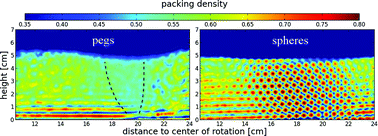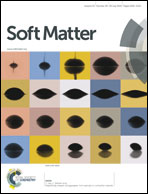Effects of grain shape on packing and dilatancy of sheared granular materials
Abstract
A granular material exposed to shear shows a variety of unique phenomena: Reynolds dilatancy, positional order and orientational order effects may compete in the shear zone. We study granular packing consisting of macroscopic prolate, oblate and spherical grains and compare their behaviour. X-ray tomography is used to determine the particle positions and orientations in a cylindrical split bottom shear cell. Packing densities and the arrangements of individual particles in the shear zone are evaluated. For anisometric particles, we observe the competition of two opposite effects. On the one hand, the sheared granules are dilated, on the other hand the particles reorient and align with respect to the streamlines. Even though aligned cylinders in principle may achieve higher packing densities, this alignment compensates for the effect of dilatancy only partially. The complex rearrangements lead to a depression of the surface above the well oriented region while neighbouring parts still show the effect of dilation in the form of heaps. For grains with isotropic shapes, the surface remains rather flat. Perfect monodisperse spheres crystallize in the shear zone, whereby positional order partially overcompensates dilatancy effects. However, even slight deviations from the ideal monodisperse sphere shape inhibit crystallization.


 Please wait while we load your content...
Please wait while we load your content...